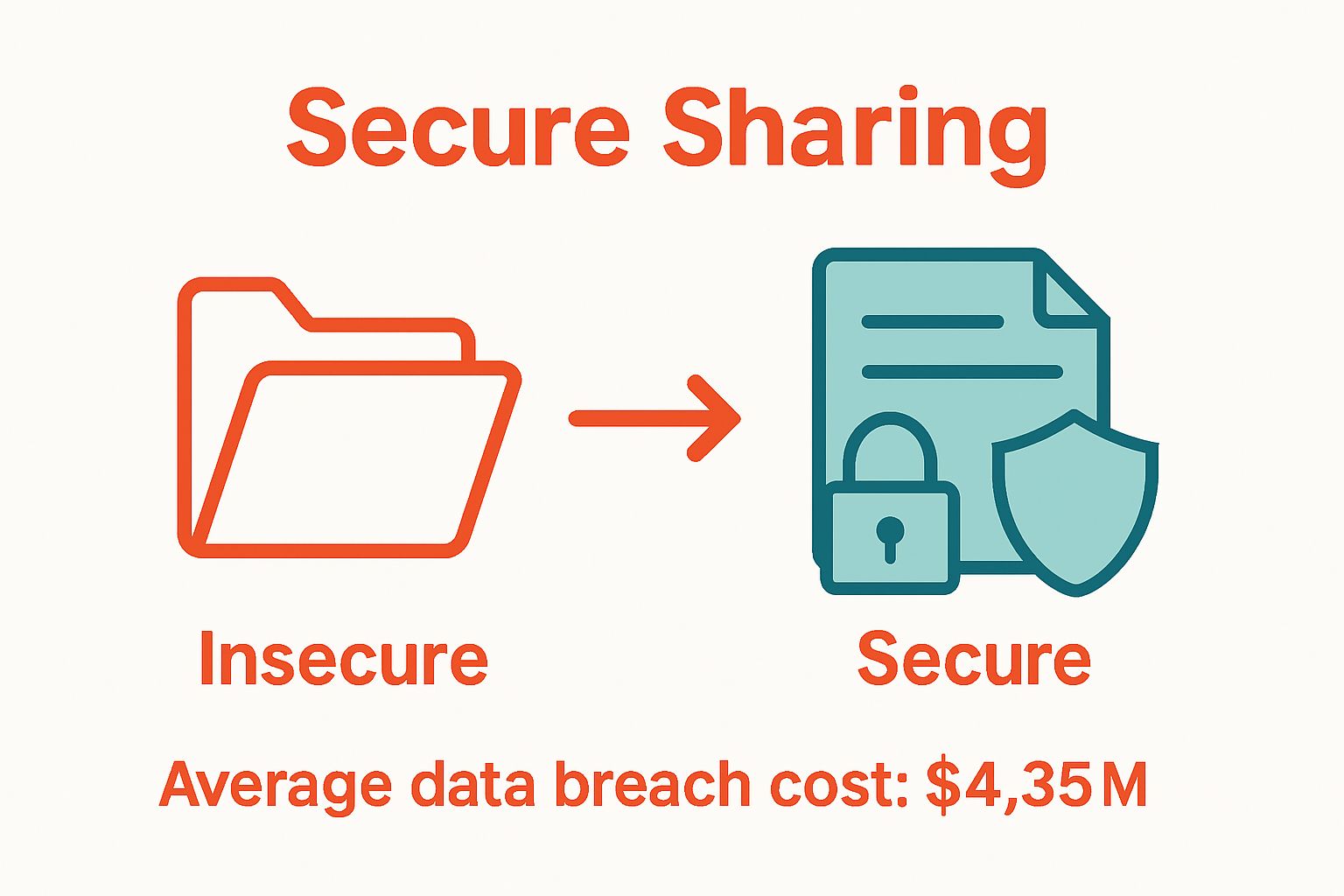
What is Secure File Sharing? Understanding Its Importance
Sharing digital files is now a daily part of business, but with sensitive information flying across networks, data security worries are at an all-time high. Some might think ordinary email attachments or cloud links are enough. Yet the stats show otherwise. The average cost of a data breach soared to $4.35 million in 2022. Suddenly, secure file sharing is not fancy tech talk. It is the difference between peace of mind and a devastating financial blow.
Table of Contents
- Defining Secure File Sharing: What It Is
- The Importance of Secure File Sharing for Businesses
- Key Technologies Behind Secure File Sharing
- Common Use Cases and Practical Applications
- Navigating Risks: Understanding Threats and Solutions
Quick Summary
| Takeaway | Explanation |
|---|---|
| Implement robust encryption | Use advanced encryption like AES 256-bit to protect sensitive data from unauthorized access during transfer and storage. |
| Establish strict access controls | Ensure only authenticated users can view or edit files, employing multi-factor authentication for enhanced security. |
| Regularly monitor security measures | Continuously assess vulnerability and maintain updated encryption protocols to safeguard against cyber threats. |
| Educate employees on cybersecurity | Provide training to staff on recognizing threats like phishing to create a more secure file sharing environment. |
| Utilize secure file sharing tools | Leverage established protocols such as TLS and end-to-end encryption to protect information throughout its digital journey. |
Defining Secure File Sharing: What It Is
Secure file sharing represents a sophisticated digital communication strategy designed to protect sensitive information during electronic transmission and storage. Unlike standard file transfer methods, secure file sharing integrates multiple layers of protection to safeguard data from unauthorized access, interception, or manipulation.
The Core Principles of Secure File Sharing
At its fundamental level, secure file sharing involves transmitting digital files between individuals or organizations while implementing robust security protocols. These protocols ensure that only authorized parties can access, view, or modify the shared content.
VIDEO:video_content] [Cybersecurity experts at NIST emphasize the critical importance of establishing comprehensive security measures that protect data integrity and confidentiality.
Key characteristics of secure file sharing include:
- Encryption of files during transmission and storage
- Access control mechanisms limiting file visibility
- Detailed audit trails tracking file interactions
- Secure authentication processes
- Protection against potential data breaches
Technical Mechanisms Enabling Secure Transmission
The technological infrastructure supporting secure file sharing relies on advanced cryptographic techniques. These methods transform data into complex coded formats that remain unreadable without specific decryption keys. When files are shared, they pass through secure communication channels that scramble the digital information, making interception extremely challenging for potential cybercriminals.
Modern secure file sharing solutions leverage protocols like Transport Layer Security (TLS) and end-to-end encryption. Research from MIT’s Computer Science and Artificial Intelligence Laboratory demonstrates how these technologies create multiple defensive layers that protect sensitive information throughout its digital journey.
Businesses across various sectors increasingly recognize secure file sharing as a fundamental component of their cybersecurity strategy. Whether managing financial records, healthcare documents, or confidential corporate communications, organizations require robust mechanisms that guarantee data protection without compromising operational efficiency.
By implementing comprehensive secure file sharing practices, companies can mitigate risks associated with unauthorized data access, maintain regulatory compliance, and build trust with clients and stakeholders who depend on stringent information protection protocols.
The Importance of Secure File Sharing for Businesses
Secure file sharing has transformed from an optional technological consideration to a critical business imperative in the contemporary digital ecosystem. Organizations across multiple sectors now recognize that protecting sensitive information is not just about preventing data breaches but maintaining overall operational integrity and stakeholder trust.
Financial and Reputational Risk Management
The potential consequences of insecure file sharing can be catastrophic for businesses. According to IBM’s Cost of Data Breach Report, the average total cost of a data breach reached $4.35 million in 2022, highlighting the substantial financial risks associated with inadequate data protection. These costs encompass not only direct financial losses but also include regulatory penalties, legal expenses, and long-term reputational damage.
To help clarify the unique risks businesses face without secure file sharing, the following table summarises the key consequences mentioned in the article.
| Risk Category | Description |
|---|---|
| Unauthorised Data Access | Sensitive data may be viewed or stolen by individuals without permission. |
| Compliance Violations | Failure to meet data protection regulations may result in fines or legal issues. |
| Increased Cybercrime | Greater exposure to hacking, malware, and other digital attacks. |
| Loss of Customer Confidence | Clients may lose trust in the business due to poor data handling. |
| Intellectual Property Theft | Risk of losing proprietary information to competitors or cybercriminals. |

Key risks businesses face without secure file sharing include:
- Potential unauthorized data access
- Compliance violations with data protection regulations
- Increased vulnerability to cybercrime
- Loss of customer confidence
- Potential intellectual property theft
Strategic Competitive Advantages of Secure File Sharing
Beyond risk mitigation, secure file sharing offers strategic advantages that can differentiate organizations in competitive markets. By implementing robust file sharing protocols, businesses demonstrate their commitment to data privacy and professional standards. Research from Deloitte suggests that organizations with strong digital trust mechanisms can enhance customer relationships and improve overall operational efficiency.
Moreover, secure file sharing enables seamless collaboration while maintaining stringent control over sensitive information. Companies can learn more about protecting their digital infrastructure through comprehensive backup and security strategies.
Effective secure file sharing solutions empower businesses to create controlled environments where information can be shared rapidly and securely across different departments, geographical locations, and external partner networks. This capability becomes increasingly crucial as remote work and digital collaboration continue to evolve, demanding sophisticated yet user-friendly file transmission mechanisms that balance security with accessibility.
Key Technologies Behind Secure File Sharing
Secure file sharing relies on a sophisticated array of technological solutions designed to protect digital information during transmission and storage. These technologies work collaboratively to create multiple defensive layers that safeguard sensitive data from potential cyber threats and unauthorized access.
Encryption Protocols: The Foundation of Data Protection
Encryption serves as the primary technological shield in secure file sharing, transforming readable data into complex coded formats that remain unintelligible to unauthorized parties. Advanced encryption standards like AES 256-bit create virtually impenetrable barriers that scramble file contents, ensuring that even if intercepted, the data remains unreadable without specific decryption keys.
Key encryption characteristics include:
- Symmetric encryption for rapid data processing
- Asymmetric encryption for enhanced key management
- Multi-layer encryption techniques
- Complex algorithmic transformations
- Secure key generation and management protocols
Access Control and Authentication Mechanisms
According to NIST guidelines, robust access control represents a critical component of secure file sharing infrastructure. These mechanisms ensure that only authenticated and authorized users can interact with specific files, creating granular permission systems that restrict data visibility and modification.
Modern authentication technologies incorporate multi-factor authentication, biometric verification, and sophisticated user role mapping. These approaches go beyond traditional username and password models, implementing intelligent systems that continuously validate user identities and monitor potential security anomalies.

Businesses can learn more about comprehensive server protection strategies to complement their secure file sharing infrastructure. By integrating advanced technological solutions, organizations can create comprehensive digital security ecosystems that protect sensitive information while maintaining operational efficiency.
The integration of these technological strategies ensures that file sharing becomes a controlled, traceable process where every interaction is monitored, encrypted, and protected against potential cyber vulnerabilities.
For a clearer understanding of technological strategies enabling secure file sharing, the table below outlines two key components and their main characteristics as presented in the article.
| Technology | Main Characteristics |
|---|---|
| Encryption Protocols | Transform data into unreadable formats, use AES 256-bit, support symmetric/asymmetric encryption, rely on complex algorithms, secure key management. |
| Access Control & Authentication | Restrict file access to authorised users, employ multi-factor authentication and biometrics, apply user role mapping, monitor and validate identities. |
| As digital communication continues to evolve, these technologies will remain crucial in maintaining the confidentiality and integrity of organizational data. |
Common Use Cases and Practical Applications
Secure file sharing technologies have revolutionized how organizations manage and transmit sensitive digital information across diverse professional environments. These solutions provide critical infrastructure for maintaining data confidentiality while enabling efficient collaborative workflows across various sectors.
Enterprise and Professional Services Deployment
In professional service environments, secure file sharing becomes essential for protecting client confidentiality and maintaining regulatory compliance. Legal firms, financial institutions, and consulting agencies rely on robust file sharing mechanisms to transfer sensitive documents securely.
Key professional scenarios include:
- Transmitting confidential legal agreements
- Sharing financial reports and audit documentation
- Managing client personal information
- Coordinating cross-departmental project files
- Securely exchanging medical records
Healthcare and Regulatory Compliance
Research from Healthcare Information and Management Systems Society (HIMSS) demonstrates the critical role of secure file sharing in maintaining patient data privacy. Healthcare providers must navigate complex regulatory frameworks like HIPAA, which mandate stringent data protection protocols for patient information.
Secure file sharing enables healthcare professionals to:
- Exchange patient records between specialists
- Collaborate on medical research
- Maintain comprehensive patient treatment documentation
- Protect sensitive medical imaging files
- Ensure compliance with data protection regulations
Businesses can explore comprehensive server management strategies to enhance their secure file sharing infrastructure. By implementing advanced technological solutions, organizations create resilient digital ecosystems that protect sensitive information while supporting seamless professional collaboration.
The evolution of secure file sharing continues to transform how organizations manage digital information, offering unprecedented levels of protection, efficiency, and regulatory compliance across multiple professional domains.
Navigating Risks: Understanding Threats and Solutions
Secure file sharing environments face an evolving landscape of sophisticated cybersecurity threats that continually challenge existing protective mechanisms. Understanding these potential vulnerabilities becomes crucial for organizations seeking to maintain robust digital information protection strategies.
Primary Cyber Threat Vectors
Digital file sharing platforms are consistently targeted by malicious actors employing diverse attack strategies. These threat vectors exploit potential weaknesses in transmission protocols, authentication mechanisms, and user behavior.
Critical threat categories include:
- Malware insertion during file transfer
- Phishing attempts targeting file sharing platforms
- Man-in-the-middle interception attacks
- Social engineering manipulation
- Unauthorized access through credential compromise
Comprehensive Risk Mitigation Strategies
Research from the Cybersecurity and Infrastructure Security Agency highlights the importance of developing multi-layered defense mechanisms. Organizations must implement proactive approaches that anticipate and neutralize potential security risks before they can cause significant damage.
Effective risk mitigation requires:
- Continuous security infrastructure monitoring
- Regular vulnerability assessments
- Employee cybersecurity awareness training
- Implementing zero-trust authentication models
- Maintaining updated encryption protocols
Businesses can explore detailed insights into cybersecurity threat landscapes to enhance their preparedness. By understanding potential risks and implementing comprehensive protective strategies, organizations can create resilient file sharing ecosystems that effectively counteract emerging digital security challenges.
The dynamic nature of cybersecurity demands constant vigilance, adaptability, and a proactive approach to identifying and neutralizing potential threats within secure file sharing environments.
Power Up Your Business with Trusted Secure File Sharing
Balancing security with productivity is a daily challenge for South African professionals, especially when confidential files move between teams and partners. As highlighted in the article, risks like unauthorised access and compliance failures are real threats that put your reputation and financial stability on the line. Without layered protection such as encryption, access controls and proper backups, a single breach can cost your business far more than just lost data.
Let Techtron show you how to close these gaps for good. Our team delivers proactive IT management and cybersecurity solutions that align with strict secure file sharing practices. Protect your critical records and client trust today by exploring our server management strategies or speaking with specialists who understand your industry challenges. Visit Techtron now to secure your information flow before tomorrow’s risks arrive.
Frequently Asked Questions
What is secure file sharing?
Secure file sharing is a method of transmitting digital files that incorporates multiple layers of protection to safeguard sensitive information from unauthorized access, interception, or manipulation. It ensures that only authorized parties can access, view, or modify the shared content.
Why is secure file sharing important for businesses?
Secure file sharing is vital for businesses as it protects sensitive information, mitigates financial and reputational risks associated with data breaches, and maintains compliance with regulations. It helps build trust among clients and stakeholders by ensuring data integrity and confidentiality.
What technologies are used in secure file sharing?
Secure file sharing relies on various technologies, including encryption protocols like AES 256-bit, access control mechanisms, and advanced authentication techniques such as multi-factor authentication and biometric verification. These technologies collaboratively enhance data protection and secure file transmission.
What are the common use cases for secure file sharing?
Common use cases for secure file sharing include transmitting confidential legal documents, sharing financial reports, managing patient records in healthcare, and facilitating project collaboration across various departments. These solutions ensure compliance with data protection regulations and protect sensitive information.